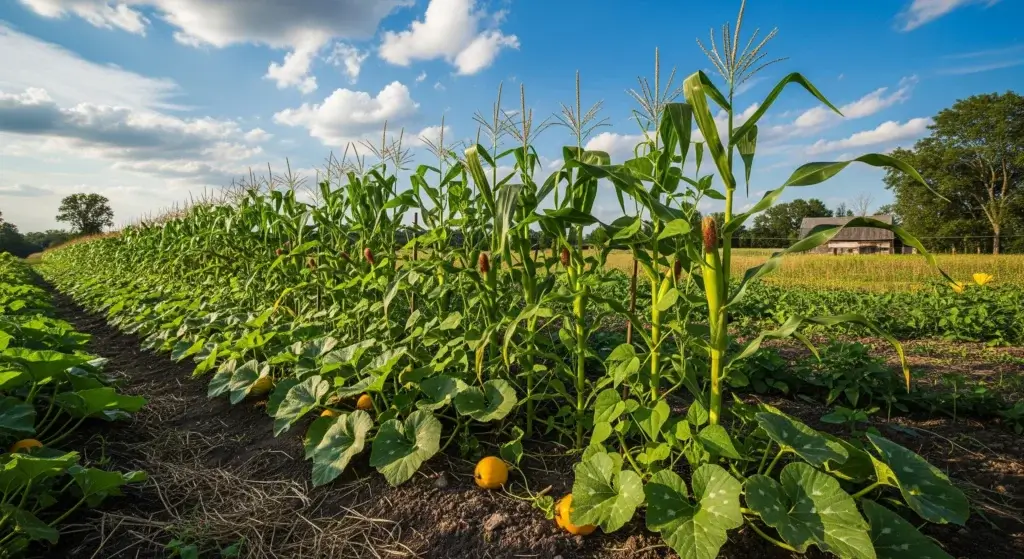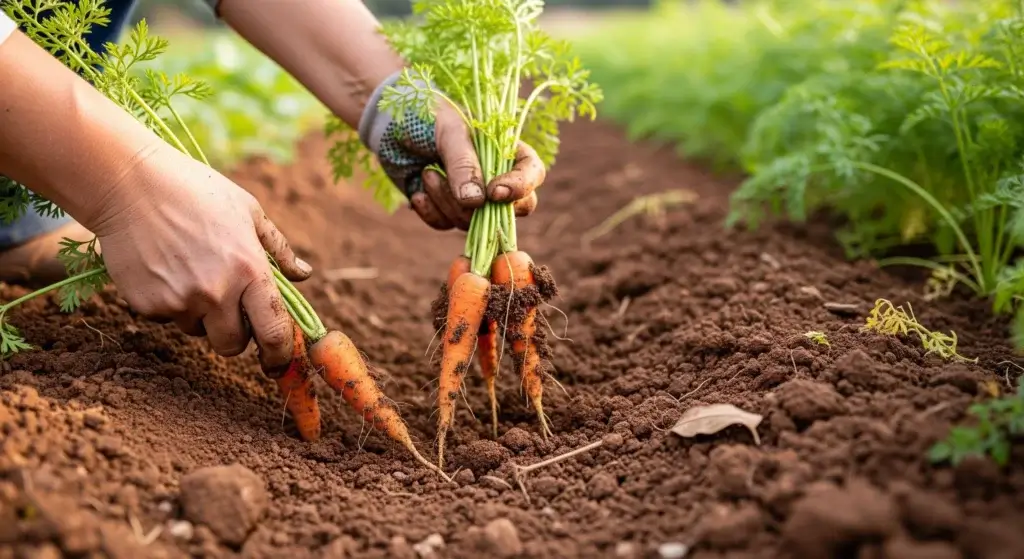
Growing vegetables in a cold climate requires careful planning and attention to detail.
The key to success lies in understanding the specific challenges of your local climate and adapting your gardening techniques accordingly.
In this article, we will explore the best vegetables for cold climates, planting strategies, and techniques to optimize your garden’s performance.
List of Vegetables that Grow Well in Cold Climates
Growing vegetables in cold climates can be highly rewarding.
Many vegetables thrive in cooler temperatures and can even withstand light frosts. Here are some of the best vegetables to grow in cold climates, along with detailed information on how to cultivate them successfully.
- Read also: Irrigation Systems For Vegetable Gardens
- Read also: A Guide to Composting for Vegetable Gardens
Leafy greens
- Kale: Kale is one of the most cold-hardy vegetables, thriving in temperatures as low as 20°F (-6°C).
- Spinach: Spinach grows well in cool weather and can be planted in early spring or fall.
- Lettuce: Lettuce varieties, such as romaine and butterhead, are well-suited for cool climates.
- Arugula: Arugula, known for its peppery flavor, thrives in cool weather. It can be planted in early spring or fall and grows quickly, allowing for multiple harvests.
- Swiss chard: Swiss chard is a versatile leafy green that can tolerate both cool and slightly warmer temperatures.
Root vegetables
- Beets: Beets are hardy vegetables that can be planted in early spring or late summer. They can tolerate light frosts and prefer well-drained soil.
- Carrots: Carrots are another cold-hardy root vegetable. They can be planted in early spring or late summer for a fall harvest.
- Turnips: Turnips grow well in cool weather and can be planted in early spring or late summer. They can tolerate light frosts and prefer well-drained soil.
- Radishes: Radishes are fast-growing and can be planted in early spring or late summer. They thrive in cool weather and can tolerate light frosts.
- Parsnips: Parsnips require a long growing season and can be planted in early spring. They can withstand frosts and even improve in flavor after exposure to cold temperatures.
Brassicas
- Broccoli: Broccoli is a cold-hardy vegetable that can be planted in early spring or late summer.
- Cauliflower: Cauliflower grows well in cool weather and can be planted in early spring or late summer.
- Cabbage: Cabbage is another cold-hardy brassica that can be planted in early spring or late summer.
- Brussels sprouts: Brussels sprouts require a long growing season and are best planted in late spring for a fall harvest.
Other options
- Peas: Peas are well-suited for cool climates and can be planted in early spring or late summer.
- Garlic: Garlic is typically planted in the fall and harvested the following summer. It requires well-drained soil and a sunny location.
- Onions: Onions can be planted in early spring or fall, depending on the variety. They require well-drained soil and full sun.

Planting Strategies for a Cold Climate
Gardening in a cold climate comes with its own set of challenges, but with the right strategies, you can still enjoy a successful and productive garden.
Know your zone
Understanding your USDA Plant Hardiness Zone is the first step in planning your garden for a cold climate.
This zone system divides the United States into regions based on average annual minimum temperatures, helping you determine which plants are suitable for your area.
By knowing your zone, you can identify your specific frost dates and plan your planting schedule accordingly.
Start early (or indoors)
In a cold climate, the growing season is often shorter, making it essential to get a head start on your garden.
Starting seeds indoors allows you to give your plants a jumpstart on the season, giving them time to grow and develop before transplanting them outside.
This is particularly beneficial for vegetables that require a longer growing season, such as tomatoes, peppers, and eggplants.
Season extension techniques
To make the most of your growing season in a cold climate, consider using season extension techniques to protect your plants from frost and cold temperatures.
Here are some effective methods:
Row covers
Row covers are lightweight fabrics that can be draped over rows of plants to provide protection from frost and cold winds.
They act as a barrier, trapping heat around the plants and creating a warmer microclimate.
Row covers come in various thicknesses, allowing you to choose the level of protection needed for your plants.
Cold frames
Cold frames are simple structures that provide shelter for tender seedlings during cool periods.
They consist of a bottomless box with a transparent lid, usually made of glass or plastic.
Cold frames capture and retain heat from the sun, creating a warm environment for young plants to thrive.
They are particularly useful for hardening off seedlings or protecting delicate crops like lettuce and spinach from early frosts.
Raised beds
Raised beds offer several benefits for gardening in a cold climate.
They provide better drainage, allowing soil to warm up more quickly in the spring and enabling earlier planting.
Raised beds also elevate plants above the ground, reducing the risk of frost damage to low-lying crops.
Additionally, the soil in raised beds tends to warm up faster and stay warmer than traditional garden beds, creating an ideal environment for heat-loving plants like tomatoes and peppers.

Optimize Your Cold Climate Garden
Gardening in a cold climate requires careful planning and thoughtful strategies to ensure a successful harvest.
By optimizing your garden with the following techniques, you can overcome the challenges of cold weather and maximize your yields.
Soil preparation
Preparing your soil is essential for creating a healthy growing environment for your vegetables.
In cold climates, where the soil can be dense and poorly draining, amending it with organic matter is crucial.
Organic matter, such as compost, well-rotted manure, or leaf mold, helps improve soil structure, increase drainage, and provide essential nutrients for plant growth.
Incorporate organic matter into the soil before planting to ensure it is thoroughly mixed and distributed.
Planting techniques
Proper planting techniques are key to the success of your garden in a cold climate.
Pay attention to spacing, planting depth, and companion planting to optimize growing conditions for your vegetables.
Spacing
Ensure that you give each vegetable variety enough space to grow to its full potential.
Crowded plants are more susceptible to disease and compete for nutrients and sunlight.
Research the specific spacing requirements for each vegetable variety and plan your garden layout accordingly.
Planting depth
Planting seeds or seedlings at the correct depth is essential for successful germination and root development.
Follow the planting instructions provided for each vegetable variety, as planting depth can vary depending on the plant’s needs.
Companion planting
Companion planting involves planting different crops together to maximize growth and deter pests.
Certain vegetable combinations can benefit each other by improving soil health, attracting beneficial insects, or repelling harmful pests.
Winterizing Tips
Protecting your garden from harsh winter elements is essential for ensuring a successful harvest the following year.
Here are some winterizing tips to help you prepare your garden for the cold season:
Mulching
Apply a layer of mulch, such as straw, leaves, or compost, around your vegetable plants to insulate the soil and protect roots from freezing temperatures.
Mulching also helps retain moisture and suppress weeds, ensuring that your plants stay healthy and hydrated throughout the winter.
Other winterizing techniques
In addition to mulching and covering raised beds, there are other winterizing techniques you can use to protect your garden.
These may include wrapping tender plants in burlap or frost cloth, providing extra insulation around root crops, or moving potted plants indoors or to a sheltered location.

- Read also: Recipes and Tips: DIY Plant Food for Vegetables
- Read also: Grow Your Own! DIY Vegetable Garden for Beginners
Conclusion
Growing vegetables in a cold climate requires careful planning and attention to detail.
By understanding the specific challenges of your local climate and adapting your gardening techniques accordingly, you can still enjoy a bountiful harvest.
Remember to choose the right vegetables for your climate, use season extension techniques, and optimize your garden’s performance through proper soil preparation and planting techniques.



